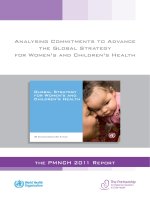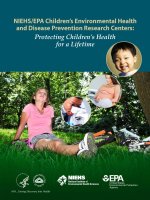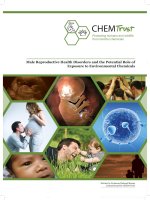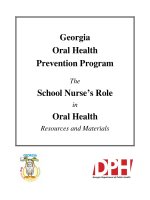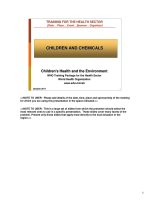Training Module 6 Children''''s Environmental Health pdf
Bạn đang xem bản rút gọn của tài liệu. Xem và tải ngay bản đầy đủ của tài liệu tại đây (693.03 KB, 34 trang )
1
PREVENTING REPRODUCTIVE
HEALTH PROBLEMS
(Draft for review)
PREVENTING REPRODUCTIVE
PREVENTING REPRODUCTIVE
HEALTH PROBLEMS
HEALTH PROBLEMS
(Draft for review)
(Draft for review)
TRAINING FOR THE HEALTH SECTOR
[Date…Place…Event…Sponsor…Organizer]
Training Module 6
Training Module 6
Children's Environmental Health
Children's Environmental Health
Public Health and the Environment
Public Health and the Environment
World Health Organization
World Health Organization
www.who.int/ceh
www.who.int/ceh
November 2011
<<NOTE TO USER: Please add details of the date, time, place and sponsorship of the
meeting for which you are using this presentation in the space indicated.>>
<<NOTE TO USER: This is a large set of slides from which the presenter should select the
most relevant ones to use in a specific presentation. These slides cover many facets of the
problem. Present only those slides that apply most directly to the local situation in the region
or replace them with your own slides and local data.>>
<<NOTE TO USER: This module presents several examples of risk factors that affect
reproductive health. You can find more detailed information in other modules of the training
package that deal with specific risk factors, such as lead, mercury, pesticides, persistent
organic pollutants, endocrine disruptors, occupational exposures; or disease outcomes, such
as developmental origins of disease, reproductive effects, neurodevelopmental effects,
immune effects, respiratory effects, and others.>>
<<NOTE TO USER: For more information on reproductive health, please visit the website of
the Department of Reproductive Health and Research at WHO:
www.who.int/reproductivehealth/en/>>
1
2
Preventing Reproductive Health Problems (Draft for review)
LEARNING OBJECTIVES
LEARNING OBJECTIVES
Understanding the importance of preventing
environmental exposures to protect reproductive
health
Understand various methods of prevention in public
health, including in the occupational setting, for the
consumer, and in personal matters
2
<<READ SLIDE.>>
Refs:
•WHO. Department of Reproductive Health and Research, Partner Brief. Geneva, Switzerland, World Health
Organization, 2009. WHO/RHR/09.02. Available at whqlibdoc.who.int/hq/2009/WHO_RHR_09.02_eng.pdf –
accessed 15 June 2011
•WHO. Preamble to the Constitution of the World Health Organization as adopted by the International Health
Conference. New York, United States of America, World Health Organization, 1946.
2
3
Preventing Reproductive Health Problems (Draft for review)
OUTLINE
OUTLINE
The importance of implementing preventive
measures
Methods of prevention
A. Occupational
B. Consumer / Policies
C. Personal
Tools available from WHO
3
<<READ SLIDE.>>
Refs:
•WHO. Department of Reproductive Health and Research. Geneva, Switzerland, World Health Organization,
2009. (WHO/RHR/09.02). Available at whqlibdoc.who.int/hq/2009/WHO_RHR_09.02_eng.pdf – accessed July
2010
•WHO. Preamble to the Constitution of the World Health Organization as adopted by the International Health
Conference. New York, USA, World Health Organization, 1946. Available at
www.who.int/about/definition/en/print.html – accessed July 2010
3
4
Preventing Reproductive Health Problems (Draft for review)
METHODS OF PREVENTION
METHODS OF PREVENTION
A. Occupational
B. Consumer/Policies
C. Personal
WHO
Prevention is cost-effective and
could have benefits that go well
beyond health, and contribute to
the overall health and well-being
of communities
Prevention is cost-effective and
could have benefits that go well
beyond health, and contribute to
the overall health and well-being
of communities
Environmental issues have been included in the United Nations Millennium Declaration as well as
several high level initiatives. However, the importance of preventive methods in various sectors is not
always fully appreciated. The following slides will describes preventive methods for different
exposure situations.
Refs:
•UN Millennium Development Goals. Available at www.un.org/millenniumgoals/bkgd.shtml accessed
20 June 2010.
•WHO. Preventing disease through healthy environments. Geneva, Switzerland, World Health
Organization, 2006.
Image: WHO, Prüss-Üstün, A. Preventing disease through healthy environments. Geneva,
Switzerland, World Health Organization, 2006.
4
5
Preventing Reproductive Health Problems (Draft for review)
A. OCCUPATIONAL EXPOSURES
A. OCCUPATIONAL EXPOSURES
Prime venue of toxic
environmental exposures
Scant research that
characterizes reproductive
hazards
A big percentage of
working men and women
are of reproductive age
5
WHO
The occupational setting is a prime venue for exposure to environmentally hazardous contaminants, including
synthetic chemicals, organic compounds, and metals. Occupational health agencies use field studies, exposure
assessments, and laboratory biomonitoring to study prioritized reproductive toxicants that may be present in the
workplace. However, it is impossible to assess the toxicity of all occupationally relevant chemicals due to their
sheer volume, complex exposure environments in the workplace, and individual susceptibility to effects.
<<NOTE TO USER: For more information regarding occupational exposures to environmental
contaminants, please see the educational training module: “Occupational Health and Children’s Risks,”
available at: www.who.int/ceh/capacity/occupational.pdf.>>
Refs:
•Endocrine Disruptor Screening and Testing Advisory Committee (EDSTAC). Recommendations to U.S. EPA
on Endocrine Disrupter Screening and Testing. Endocrine Disruptor Screening and Testing Advisory
Committee. 1998. Available at www.epa.gov/scipoly/oscpendo/edsp overview/finalrpt.htm - accessed 18 March
2010.
•Grajewski B et al. Occupational exposures and reproductive health: 2003 Teratology Society meeting
symposium summary. Birth Defects Res B Dev Reprod Toxicol. 2005, 74:157–163.
The effect of shift work, and circadian rhythm disruption, on reproductive outcomes is poorly understood,
although advances have been made in the development of metrics for measuring disruption of circadian rhythm
in working populations. One such metric is the variability of 2-sulfoxymelatonin, the urinary metabolite of
melatonin, which has been found to be correlated with travel by female flight attendants through multiple time
zones
5
6
Preventing Reproductive Health Problems (Draft for review)
OCCUPATIONAL EXPOSURES AND
OCCUPATIONAL EXPOSURES AND
REPRODUCTIVE HEALTH
REPRODUCTIVE HEALTH
Possible effects on future
fathers
Decreased sperm count
–
Estrogens, lead
Decreased sexual drive
–
Chloroprene, stress
Changes in genetic
material (birth defects)
–
Radiation, pesticides
Possible effects on future
mothers
Menstrual disorders
– Ionizing radiation, pesticides,
fumonisins
Reduced fertility
– Arsenic, benzene, pesticides
Changes in genetic material
(birth defects, miscarriages)
– Cadmium, mercury, pesticides
6
Future parents can be exposed at their workplaces to many occupational health risks that can affect their ability
to have children or the health of their future children. Both men and women can be affected by reproductive
occupational health risks.
Exposures to some chemicals or to stressful conditions may cause both male and female workers to experience
a decrease in their desire or ability to have sex. For example, some chemicals may have depressant effects,
such as certain solvents, and thus can suppress the libido (sex drive).
Occupational exposures can also cause menstrual problems, which may prevent ovulation from taking place.
Stress, working on shifts, or exposure to certain organic solvents can disrupt the normal menstrual cycle, which
in turn can affect fertility. Another possible effect of exposure to certain occupational hazards is their ability to
cause direct damage to the germ cells (sperm and eggs). Radiation and certain chemicals can cause decreased
fertility or even sterility.
Occupational risks can reduce the number of sperm to a level below the minimal necessary for fertilization.
Certain occupational hazards can cause mutations in genetic material that can be passed on to future
generations. Such hazards are called mutagens. Genetic mutations can result in birth defects, stillbirth or
miscarriage, depending on the type of damage caused.
Refs:
•International Labour Organization (ILO). Male and female reproductive hazards in the workplace. ILO.
Available at actrav.itcilo.org/actrav-english/telearn/osh/rep/prod.htm – accessed 10 June 2011
•US Navy Environmental Health Centre. Reproductive and developmental hazards: a guide for occupational
health professionals. US Navy Environmental Health Centre, 2001, available at www-
nehc.med.navy.mil/Downloads/Occmed/Reprodev2006.pdf - accessed 10 June 2011
6
7
Preventing Reproductive Health Problems (Draft for review)
MECHANISMS FOR PREVENTING
MECHANISMS FOR PREVENTING
OCCUPATIONAL EXPOSURES
OCCUPATIONAL EXPOSURES
Regulatory mechanisms:
– Encouraging “clean technologies”
– Implementing effective occupational exposure limits
• For chemicals with threshold effects and carcinogenic endpoints
– Right-to-Know (US legal principle that individuals have the right to
know the chemicals to which they may be exposed in their daily
living)
– Industrial occupational regulations
• Provisions of personal protective equipment (PPE) for workers
Individual mechanisms
– Nutritional supplementation
• e.g. folate supplements for women
– Knowledge of workers’ rights
– Worker education on adherence to safety guidelines and
personal
protective equipment
7
<<READ SLIDE>>
A study (Ormond et. al) found that although mothers exposed occupationally to endocrine disruptors faced an increased risk for fetal
developmental disorders, folate supplementation during the first three months of pregnancy could significantly decrease the aforementioned
risk. In the United States, the "Right to know" is the legal principle that individuals have the right to know the chemicals to which they may be
exposed in their daily living. "Right to Know" US can address the community and the workplace "Right to Know".
Note: PPE is Personal Protective Equipment
Refs:
•Ormond G et al. Endocrine Disruptors in the Workplace, Hair Spray, Folate Supplementation, and Risk of Hypospadias: Case–Control Study.
Environ Health Perspect. 2009, 117:303-307.
Hypospadias is one of the most common urogenital congenital anomalies affecting baby boys. Prevalence estimates in Europe range from 4 to
24 per 10,000 births, depending on definition, with higher rates reported from the United States. Relatively little is known about potential risk
factors, but a role for endocrine-disrupting chemicals (EDCs) has been proposed. Our goal was to elucidate the risk of hypospadias associated
with occupational exposure of the mother to endocrine-disruptor chemicals, use of folate supplementation during pregnancy, and vegetarianism.
We designed a case–control study of 471 hypospadias cases referred to surgeons and 490 randomly selected birth controls, born 1 January
1997–30 September 1998 in southeast England. Telephone interviews of mothers elicited information on folate supplementation during
pregnancy and vegetarianism. We used a job exposure matrix to classify occupational exposure.ResultsIn multiple logistic regression analysis,
there were increased risks for self-reported occupational exposure to hair spray [exposed vs. nonexposed, odds ratio (OR) = 2.39; 95%
confidence interval (CI), 1.40–4.17] and phthalate exposure obtained by a job exposure matrix (OR = 3.12; 95% CI, 1.04–11.46). There was a
significantly reduced risk of hypospadias associated with of folate use during the first 3 months of pregnancy (OR = 0.64; 95% CI, 0.44–0.93).
Conclusions: Excess risks of hypospadias associated with occupational exposures to phthalates and hair spray suggest that antiandrogenic
EDCs may play a role in hypospadias. Folate supplementation in early pregnancy may be protective.
•Damgård Nielse G, Ovrebo S. Background, approaches and recent trends for setting health-based occupational exposure limits: A minireview.
Regul Toxicol Pharmacol. 2008. 51(3): 253-269.
The setting of occupational exposure limits (OELs) are founded in occupational medicine and the predictive toxicological testing, resulting in
exposure–response relationships. For compounds where a No-Observed-Adverse-Effect-Level (NOAEL) can be established, health-based
OELs are set by dividing the NOAEL of the critical effect by an overall uncertainty factor. Possibly, the approach may also be used for
carcinogens if the mechanism is epigenetic or the genetic effect is secondary to effect from reactions with proteins such as topoisomerase
inhibitors, and mitotic and meiotic spindle poisons. Additionally, the NOAEL approach may also be used for compounds with weak genotoxic
effect, playing no or only a minor role in the development of tumours. No health-based OEL can be set for direct-acting genotoxic compounds
where the life-time risks may be estimated from the low-dose linear non-threshold extrapolation, allowing a politically based exposure level to be
set. OELs are set by several agencies in the US and Europe, but also in-house in major chemical and pharmaceutical companies. The
benchmark dose approach may in the future be used where it has advantage over the NOAEL approach. Also, more attention should be
devoted to sensitive groups, toxicological mechanisms and interactions as most workplace exposures are mixtures.
7
8
Preventing Reproductive Health Problems (Draft for review)
RECOMMENDATIONS FOR INDUSTRY
RECOMMENDATIONS FOR INDUSTRY
Increase screening of chemicals
–
Gap exists between the number of chemicals that are in
commerce and the number that have been thoroughly tested
Apply regulatory policies
–
Ensure worker protection via legislation
Increase spectrum of population considered “exposed”
–
Not only women of childbearing age but also all working women,
all working men, and all of their potential offspring
New end points of reproductive health assessments
– Female entry into menopause transition
8
Due in part to the ever increasing number of chemicals that are created every year, effective screening methods
should be employed to gauge safety before they are used. High cost of screening assays is the prime reason
for the gap that exists between existing chemicals and screened chemicals.
Because the transition to menopause marks the beginning of a series of important hormonal change,
occupational health agencies have suggested using this female endpoint in worker health assessments. A
standard definition of the start of the menopausal transition would also allow important comparisons across
occupational health studies.
Ref:
•Lisabeth L, Harlow S, Qaqish B. A new statistical approach demonstrated menstrual patterns during the
menopausal transition did not vary by age at menopause. J Clin Epidemiol. 2004. 57: 484–496
8
9
Preventing Reproductive Health Problems (Draft for review)
RECOMMENDATIONS FOR WORKERS AND
RECOMMENDATIONS FOR WORKERS AND
EMPLOYERS
EMPLOYERS
Pregnant women should not work without protection in
occupational settings that put them at risk for exposure
Mining with mercury
Spraying crops with pesticides
Open dialogue with employers
about occupational safety and
methods of preventing
exposures
Pay close attention to health status, do not ignore symptoms
9
WHO
<<READ SLIDE.>>
Image: WHO
9
10
Preventing Reproductive Health Problems (Draft for review)
EXAMPLE: PREVENTING PESTICIDE
EXAMPLE: PREVENTING PESTICIDE
EXPOSURE
EXPOSURE
Do not use pesticides unnecessarily
Promote the use of safer pest control methods in agriculture and the
protection of agricultural workers
Do not participate in occupational pesticide application if pregnant or
if you plan to be pregnant in near future
Do not allow children to participate in occupations with pesticide
exposure
If employed in occupations with pesticide exposure, utilize personal
protective equipment, if possible
Change your clothes after occupational exposure to avoid take
home exposure risks
Avoid unnecessary use of pesticides around home environment;
when pest control is needed use the safest possible method like bait
traps
Apply pesticides with methods that avoid drift into surrounding
communities and contamination of food and drinking water supplies
10
<<READ SLIDE.>>
<<NOTE TO USER: Please adapt this slide to your specific country or region.>>
Ref:
•Stillerman KP et al. Environmental exposures and adverse pregnancy outcomes: a review of the science.
Reproductive Sciences, 2008, 15(7): 631-650.
10
11
Preventing Reproductive Health Problems (Draft for review)
FUTURE OCCUPATIONAL CHALLENGES
FUTURE OCCUPATIONAL CHALLENGES
Rise of nanotechnology
–
Reproductive risks have not been studied; can some
nanomaterials cross the placenta? Are some potentially
developmental toxicants?
–
Lack of data: need to investigate the potential reproductive
health risks in occupational settings
Multiplicative or synergistic exposures
– Physical hazards in concert with chemical hazards (mixtures)
– How to develop appropriate risk assessment paradigms if
exposure to each chemical is below “safe level” but
cumulative exposures are too great?
11
Engineered nanomaterials are uniformly sized materials < 100 nm (1 nanometer = 10
9
meter)]. The
potential toxicological hazards associated with the increasing commercial uses of nanotechnology
are not well understood.
In terms of multiple exposures and synergistic effects of chemicals, greater research is needed on
the specific mechanisms of toxicity of toxicants in order to understand what sort of risk assessment
framework can be used. The effects of physical hazards in concert with chemical hazards will be very
difficult to assess as exposures increase. Whole-body vibration can affect androgen levels just as
chemical toxicants can (Cardinale and Pope 2003).
Ref:
•Cardinale M, Pope MH. The effects of whole body vibration on humans: dangerous or
advantageous? Acta Physiol Hung. 2003, 90(3):195–206.
•Colvin V. The potential environmental impact of engineered nanomaterials. Nat Biotechnol. 2003,
21:1166–1170
More information:
•International Labour Organization. www.ilo.com
•WHO. Healthy workplaces: a model for action. For employers, workers, policy-makers and
practitioners. WHO. 2011.
•WHO Occupational health homepage:www.who.int/occupational_health/healthy_workplaces/en/
11
12
Preventing Reproductive Health Problems (Draft for review)
B. CONSUMER PROTECTION FROM
B. CONSUMER PROTECTION FROM
ENVIRONMENTAL EXPOSURES
ENVIRONMENTAL EXPOSURES
Actions can be taken at multiple levels:
– Societal / policies
– Industry/business
– Individual
12
WHO
<<READ SLIDE.>>
12
13
Preventing Reproductive Health Problems (Draft for review)
SOCIETAL ACTIONS FOR CONSUMER
SOCIETAL ACTIONS FOR CONSUMER
PROTECTION
PROTECTION
Need for a coordinated effort between researchers, elected
officials, medical professionals, and business leaders to
continue research into field of reproductive health and the
environment:
1. Support better research on potential reproductive health toxicants,
including long-term and multi-generational studies
2. Support policies that prevent exposure to environmental agents
that have not been proven safe
3. Research on synergistic exposures and mixtures
4. Research to identify susceptible populations
13
<<READ SLIDE.>>
As a society, there is need for coordinated actions, international agreements, and strengthened domestic laws.
Refs:
•Stillerman, KP et al. Environmental Exposures and Adverse Pregnancy Outcomes: A Review of the Science.
Reproductive Sciences, 2008, 15(7): 631-650.
•The Collaborative on Health and the Environment. Hormone Disruptors and Women’s Health: Reasons for
Concern. Available at www.healthandenvironment.org/articles/doc/5492 - accessed March 20, 2010.
•WHO. Preventing Disease Through Healthy Environments. Geneva, Switzerland, World Health Organization,
2006.
13
14
Preventing Reproductive Health Problems (Draft for review)
EXAMPLES OF INTERNATIONAL
EXAMPLES OF INTERNATIONAL
AGREEMENTS
AGREEMENTS
Stockholm Convention on Persistent Organic Pollutants
(POPs)
–
Signed by 90 countries in 2001 to eliminate or reduce the use of
persistent organic pollutants including DDT
(dichlorodiphenyltrichloroethane), PCBs (polychlorinated
biphenyls), dioxins
–
Provisions to add additional POPs to Convention
Rotterdam Convention on Prior Informed Consent
– Includes a number of the most toxic organophosphate pesticides
and other very hazardous substances
– Allows member nations the right to refuse import of harmful
substances on the Prior Informed Consent list
14
Organochlorine pesticides are highly lipophilic organic pollutants that persist in the environment, accumulate in
the food chain and are regularly detected in humans. Dichlorodiphenyltrichloroethane (DDT) was banned in the
US in the 1970s. Replacement pesticides for DDT are insecticides such as organophosphates.
Organophosphate pesticides are the most heavily used pesticide products in US agriculture.
Organophosphate pesticides inhibit the acetylcholinesterase in synaptic clefts, which then deregulates the
metabolism of acetylcholine.
Acetylcholine is a neurotransmitter to critical to skeletal-muscle motor neurons. Continued inhibition causes
accumulation of acetylcholine at the neuronal junctions and results in continued stimulation and then
suppression of the neurotransmission.
Ref:
•Stillerman, KP et al. Environmental Exposures and Adverse Pregnancy Outcomes: A Review of the Science.
Reproductive Sciences, 2008, 15(7): 631-650.
Rotterdam Convention - www.pic.int/ - accessed 10 June 2011
Stockholm Convention - www.pops.int/ - accessed 10 June 2011
14
15
Preventing Reproductive Health Problems (Draft for review)
NATIONAL LEGISLATION
NATIONAL LEGISLATION
National legislation is needed to:
- Track the introduction and presence of chemicals and
pesticides in society
- Provide authorities for import and export and
obligations under international agreements
- Provide authority for provision of hazard and
exposure information, registration and authorization
uses of pesticides and industrial chemicals
<<READ SLIDE.>>
Refs:
•WHO. Preventing disease through healthy environments. Geneva, Switzerland, World Health Organization,
2006. Available at www.who.int/quantifying_ehimpacts/publications/preventingdisease/en/index.html - accessed
21 September 2011.
•Program on Reproductive Health and the Environment. Shaping our legacy: reproductive health and the
environment. University of California, San Francisco. 2008.
16
Preventing Reproductive Health Problems (Draft for review)
ACTIONS BY INDUSTRY
ACTIONS BY INDUSTRY
WHY?
–
Corporate Responsibility!
Manufacturers
–
Switch to cleaner technologies
–
Provide clear information about hazards of products and
necessary protections by workers and consumers
–
Provide worker protection and education
–
Assure safety of all products intended for use by children
Retailers
–
Identify and market products that are safer for consumers
–
Facilitate consumer choice of safer products
–
Provide clear information about safe use of products
<<READ SLIDE.>>
Refs:
•National Public Health Partnership. Application of risk management principles in public health legislation.
Washington DC, USA, Department of Human Services, 2000. Available at
www.dhs.vic.gov.au/nphp/publications/legislation/riskmgtrep.pdf – accessed 15 June 2011
•WHO. Preventing disease through healthy environments. Geneva, Switzerland, World Health Organization,
2006.
17
Preventing Reproductive Health Problems (Draft for review)
C. PERSONAL METHODS OF PREVENTION
C. PERSONAL METHODS OF PREVENTION
Individuals can take specific actions to limit
exposure
Education is KEY to
limiting personal
exposure
WHY?
– Government policies and regulations may take time
– Long term persistence even after chemical ban
17
WHO
<<READ SLIDE.>>
Refs:
•National Public Health Partnership. Application of Risk Management Principles in Public Health Legislation.
Washington DC, USA, Department of Human Services, 2000. Available at
www.dhs.vic.gov.au/nphp/publications/legislation/riskmgtrep.pdf – accessed 15 June 2011
•The Collaborative on Health and the Environment. Hormone Disruptors and Women’s Health: Reasons for
Concern. Available at www.healthandenvironment.org/articles/doc/5492 - accessed March 20, 2010.
•WHO. Healthy Environments for Healthy Children. Key Messages for Action. WHO, 2010. Available at
www.who.int/ceh/publications/hehc_booklet/en/index.html accessed 10 June 2010
Image: WHO
17
18
Preventing Reproductive Health Problems (Draft for review)
LIMITING PERSONAL EXPOSURE VIA FOOD
LIMITING PERSONAL EXPOSURE VIA FOOD
Wash fruits and vegetables prior to consumption to
reduce pesticide exposure
If possible, buy organic or plant your own crops and do
not use pesticides
Reduce the amount of animal fat consumed
–
Contaminants may bioaccumulate in animal fats
Pay special attention to food labels and local dietary
warnings and advisories, especially for pregnant
women and children
18
<<READ SLIDE.>>
<<NOTE TO USE: For more information regarding personal exposures via food sources, please see the
module entitled, “Children and Food Safety,” located at: />Refs:
•Joint FAO/WHO Expert Committee on Food Additives (JECFA). WHO Food Additive Series. Geneva,
Switzerland, World Health Organization, 2008. Available at
www.who.int/ipcs/publications/jecfa/monographs/en/index.html - accessed 15 June 2011
•National Resources Defense Council. Endocrine disruptors. Available at
www.nrdc.org/health/effects/qendoc.asp - Accessed March 22, 2010.
•WHO. Healthy Environments for Healthy Children. Key Messages for Action. WHO, 2010. Available at
www.who.int/ceh/publications/hehc_booklet/en/index.html accessed 10 June 2010
18
19
Preventing Reproductive Health Problems (Draft for review)
FISH CONSUMPTION
FISH CONSUMPTION
Fish is a health promoting food that contains omega-3
fatty acids beneficial to fetal and child development and
prevention of chronic disease
However, fish bioaccumulate environmental contaminants
– Polychlorinated biphenyls (PCBs)
– Metals (mercury)
What you can do:
1. When pregnant or planning pregnancy, consume fish that
are lower in risk for contamination – e.g. avoid seafood
near the top of the food chain, such as shark
2. Diversify protein diet if possible
3. Pay attention to local advisories if available
19
<<READ SLIDE.>>
Refs:
•Barron, M.G. Bioaccumulation and bioconcentration in aquatic organisms. In: Hoffman DJ et al eds. Handbook of
Ecotoxicology, Lewis, Boca Raton, FL, USA. 1995: 652–666.
•Joint FAO/WHO Expert Committee on Food Additives (JECFA). WHO Food Additive Series. Geneva, Switzerland, World
Health Organization, 2008. Available at www.who.int/ipcs/publications/jecfa/monographs/en/index.html - accessed 15 June
2011
19
20
Preventing Reproductive Health Problems (Draft for review)
EXAMPLE OF FISH CONSUMPTION GUIDELINES
EXAMPLE OF FISH CONSUMPTION GUIDELINES
For diets based on fish that may have high levels
of mercury:
Determine amount, type and frequency of fish
consumption and provide advice
Encourage consumption of fish low in methylmercury, but:
– Limit intake of larger, predatory fish
– Greatly limit intake of marine mammals
– Encourage consumption of "light" or "chunk light" tuna
The advice to families in developing countries, especially those with diets based on fish, is
quite different. When possible, limit intake of large fish who eat other fish. Smaller and
younger fish are likely to have lower mercury levels. By eating a variety of fish, exposure is
also likely to be reduced.
<<READ SLIDE>>
<<READ SLIDE: Please replace with examples of your local advisories>>
Refs:
•WHO. Exposure to mercury: a major public health concern. Available at
www.who.int/phe/news/Mercury-flyer.pdf - accessed 21 September 2011.
•Oken E et al. Maternal fish intake during pregnancy, blood mercury levels, and child
cognition at age 3 years in a US cohort. Am J Epidemiol. 2008 May 15;167(10):1171-81.
21
Preventing Reproductive Health Problems (Draft for review)
EXAMPLE: BREATHING EASIER
EXAMPLE: BREATHING EASIER
Prevent airborne exposures to contaminants:
Do not smoke and encourage others to keep your home
smoke free
Avoid open burning of trash and other materials
Avoid burning biomass fuel inside your home or dwelling and
keep the spaces well ventilated
Walk or bike when possible, limit use of motor vehicles
and motor vehicle idling
Keep a clean home-
indoor pollutants such as
dust, mould, and pet dander
may trigger asthma
symptoms or allergies
21
WHO
<<READ SLIDE.>>
Refs:
•WHO. Healthy Environments for Healthy Children. Key Messages for Action. WHO, 2010. Available at
www.who.int/ceh/publications/hehc_booklet/en/index.html accessed 10 June 2010
Image: WHO
21
22
22
Preventing Reproductive Health Problems (Draft for review)
22
HEALTH CARE PROVIDERS AND PREVENTION
HEALTH CARE PROVIDERS AND PREVENTION
EFFORTS
EFFORTS
Health care providers play a key role in:
Identifying the problem
Defining its determinants and
characteristics
Informing the community
Educating colleagues and other
professionals
Raising the awareness of policy-makers
Promoting the implementation of the
appropriate measures
Helping to evaluate the efficacy of
preventive measures
WHO
<< NOTE TO USER: mention success stories of prevention of toxic exposures and exposure to pollutants. Give examples that are
pertinent to the area and/or your personal experience on the subject.>>
Health care providers play a key role in many aspects of the prevention of exposure. These are:
•Identifying the problem. What are the main toxic exposures? What are the main causes of acute poisonings? Are there any cases of chronic
exposure to environmental pollutants? Is there a high incidence of diseases that may be linked to chemicals in the environment?
Emergencies and poisons centres are able to provide statistical and epidemiological data on the subject.
•What are the determinants and characteristics? Are exposures acute or chronic? Where do they occur? When and how? Are there any
predisposing factors? Which populations or groups are affected? Are they predominantly urban or rural?
•Informing the community – the workers, the families. A community exposed to chemicals and pollutants in the environment should be
informed about the situation in a clear manner (do not hide! do not scare!). Social workers and communications experts may provide
valuable advice on how to communicate risks or potential threats to the community, and how its members may avoid them and protect their
own.
•Educating colleagues and other professionals. It is especially important to educate those who should recognize and manage the effects of
chemicals on health (e.g. nurses, physicians, midwives. primary health care workers). Those who will help in assessing environmental issues
should also be educated.
•Raising the awareness of policy-makers about the problems identified. Policy-makers should be made aware of the risks communities face –
poisonings and potential chronic exposures.
•Promoting the implementation of the appropriate actions. The implementation of the appropriate measures should be promoted in
consultation with key partners including policy-makers, midwives, doctors, nurses, communities.
•Evaluating the efficacy of preventive measures. The efficacy of preventive measures should be evaluated and, again, the community should
be informed of the findings!
Refs:
•Program on Reproductive Health and the Environment. Shaping our legacy: reproductive health and the environment. University of
California, San Francisco. 2008.
•WHO. Healthy Environments for Healthy Children. Key Messages for Action. WHO, 2010. Available at
www.who.int/ceh/publications/hehc_booklet/en/index.html accessed 10 June 2010
23
Preventing Reproductive Health Problems (Draft for review)
IF PREGNANT (TRADITIONAL ADVICE)
IF PREGNANT (TRADITIONAL ADVICE)
Many pregnancy/birth problems could be avoided through:
– Family planning
– Balanced diet
– Management of maternal health problems
– Avoiding maternal infection
Usual advice:
Folic acid in flour to prevent neural tube defects
Iodine in salt to prevent congenital hypothyroidism
Vit B
12
(methyl donor important for DNA and protein modification)
around conception
Rubella vaccination to prevent congenital rubella syndrome
Doctors traditionally give advice to pregnant women that includes, among others, taking folic
acid supplements, vitamins and getting rubella vaccinations (if not yet vaccinated).
Refs:
•Fleming TP et al. The embryo and its future. Biology of Reproduction, 2004, 71: 1046.
•The March of Dimes global report on birth defects, the hidden toll of dying and disabled
children.
Available at www.marchofdimes.com/professionals/871_18587.asp – accessed May 2011.
24
Preventing Reproductive Health Problems (Draft for review)
HOW TO REDUCE EXPOSURE?
HOW TO REDUCE EXPOSURE?
Examples of advice for patients
Don't smoke! Nor stay near smokers
No alcohol during pregnancy
No use of drugs
Consult your doctor before taking medications
Eat food without additives, without pesticides
and preservatives
Avoid fat in meat
Avoid fish rich in persistent organic pollutants
and mercury (bigger fish)
Observe fish advisories on mercury
Avoid microwaving plastics
Don't use solvents – avoid paints
Reduce the number of chemical cleaners at home
WHO
Other advice that could consider environmental risk factors could include:
<<READ SLIDE>>
<< NOTE TO USER: Please adapt the advice to your own context/region.>>
25
Preventing Reproductive Health Problems (Draft for review)
TOOLS AND MECHANISMS
TOOLS AND MECHANISMS
25
Promotion of collaborative research between
industrialized and developing countries:
• To address reproductive health problems in their
national and global contexts
• To plan and implement prevention and remediation
strategies
• To put in place evidence-based public health policies
at the country level
• To transfer technology and capacity building, and the
build up of a network of trained scientists
This is an example of the many tools from WHO available on environment and health. More research is needed
in the area of reproductive health and environment. Coordinated collaborative research will yield useful
answers. More information: www.who.int/reproductivehealth/en
<<READ SLIDE.>>
Ref:
•WHO. Healthy Environments for Healthy Children. Key Messages for Action. WHO, 2010. Available at
www.who.int/ceh/publications/hehc_booklet/en/index.html accessed 10 June 2010
25



